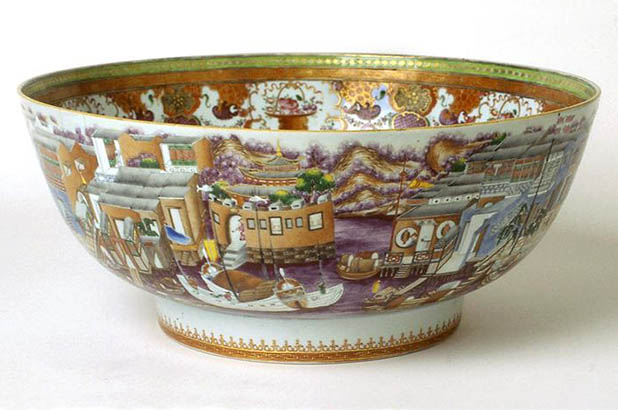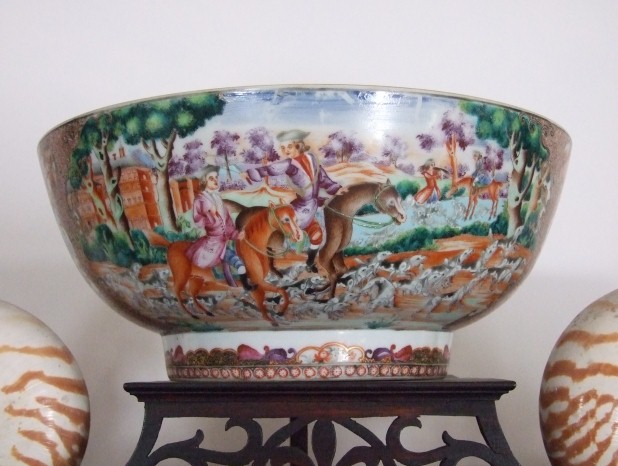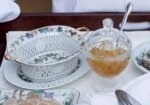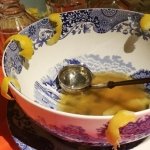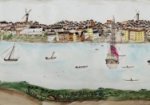Every object carries a story of its history and what it represents. Some objects however actually show you their story; punchbowls are a great example.
On the banks of the Pearl River
In the 19th century, European trade with China was carried out in a tightly controlled environment along a narrow strip beside the Pearl River in Canton (now Guangzhou). Thirteen hongs (warehouses or factories) were located there, each of which served as office, warehouse and residence combined for European merchants, who were only permitted to venture a short distance beyond them. A virtual flood of ceramics, furniture, curios and foodstuffs from China left from this narrow strip bound for the rest of the world, including New South Wales.
Chinese porcelain, usually manufactured inland at the city of Jingdezhen but left plain, was brought in huge quantities to Canton where it could be decorated ‘to order’. Some porcelain was in recognisably Chinese forms, while others were distinctly European, such as the meat trays and soup tureens of western-style dinner services. The Macarthur dessert service is just one example. Decoration also varied between Chinese style, often augmented with European monograms, and ‘European’ content.
In the case of punchbowls, a well-known genre of scenic decoration was of the hongs themselves.
The punchbowl below – on display at the Museum of Sydney next to the ‘Trade Wall’ on level 2 – depicts the 13 hongs that lined the Pearl River. The nationality of the individual factories can be identified by the flags flying in front of each. Note the flagpole in front of the Danish hong at the left, the European merchants in discussion with their Chinese counterparts, and the sampans moored alongside the river edge:
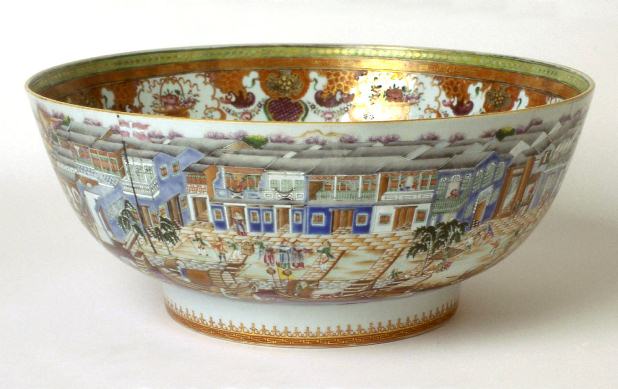
Chinese export ‘Hong’ punchbowl, made in Jingdezhen, Jiangxi province, China, c1780–85. Caroline Simpson Collection, Historic Houses Trust
In this c1805 painting of the hongs from the Caroline Simpson Collection, you can again see the Danish factory with its flag (a white cross on a red ground) at the far left:
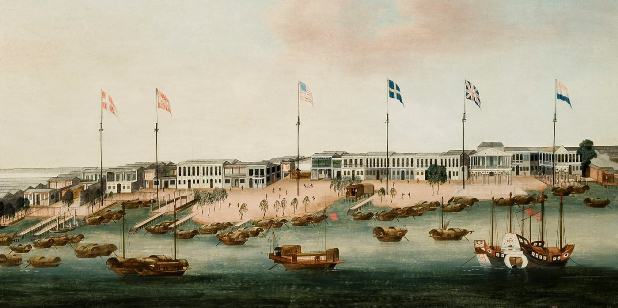
Canton; the western Hongs (detail), artist unknown, c1805. Caroline Simpson Collection, Historic Houses Trust
In this later view – showing tea chests being loaded onto a smaller boat, ready to be conveyed out to a larger merchant ship moored elsewhere in the river – the scene has changed, following a disastrous fire in 1841:
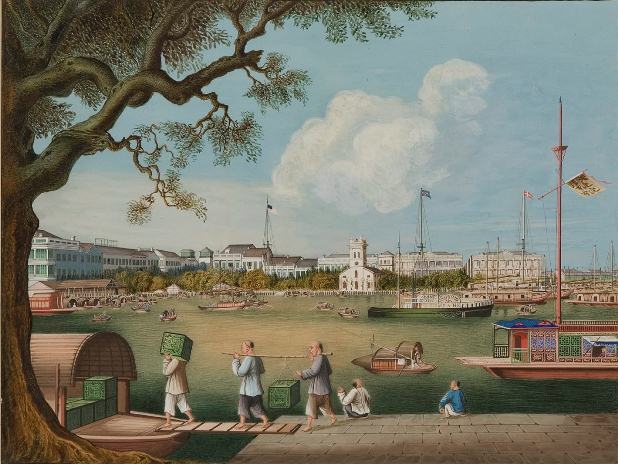
The waterfront at Canton with the American, British and Danish factories and the Protestant Church, Studio Tingqua (active 1840–1870), c1847–56. Caroline Simpson Collection, Historic Houses Trust
The landscape was about to change again dramatically when, in December 1856, the church along with the surrounding factories were destroyed during the second Opium War.
Two special Sydney punchbowls
Two other very rare punchbowls are in public collections in Sydney. These, however, do not show the hongs in China, but instead show the other end of our very own trade route from the East: Sydney Cove.
The first is in the collection of the State Library of NSW. Around the outside is a panorama taken from Bennelong Point looking westward, while the inside of the bowl is decorated with a band of exuberant Chinese flowers. At the centre is a vignette of an Indigenous Australian ceremony, possibly adapted from a scene published in de Freycinet’s Voyages autour du monde (Paris, 1825). Details in the scene enable the bowl to be dated to just before 1820.
![[Chinese export ware punchbowl featuring a scene of Sydney Cove before 1820]. Mitchell Library, State Library of NSW: XR 10 Various tyes of flowers decorate the inside rim of the punchbowl, with a scene depicting Sydney Cove on the outside.](../../app/uploads/sites/2/2013/02/xa281005h_reduced-blog-sized-618x410.jpg.pagespeed.ic.Pr0pdXySjT.jpg)
[Chinese export ware punchbowl featuring a scene of Sydney Cove before 1820]. Mitchell Library, State Library of NSW: XR 10
![[Chinese export ware punchbowl featuring a scene of Sydney Cove before 1820]. Mitchell Library, State Library of NSW: XR 10 A scene depicting Sydney Cove decorates the outside of the punchbowl .](../../app/uploads/sites/2/2013/02/xa281012h_reduced-blog-sized-618x291.jpg.pagespeed.ic.2pqWO5mgVJ.jpg)
[Chinese export ware punchbowl featuring a scene of Sydney Cove before 1820]. Mitchell Library, State Library of NSW: XR 10
And now for something completely different:
A punchbowl at our own Elizabeth Bay House is also of Chinese export ware, but dates to around 1760 and has a very different subject. In the vivid colours typical of Chinese famille vert ceramics, it portrays a European deer hunt, with a pack of dogs and mounted, tricorn-hatted hunters careering over the hillsides. It was painted by an artisan who, working from an imported artwork, could only guess what such a scene would actually look like. As a side note, the bowl is displayed as a curio atop an insect cabinet in the house’s library, flanked by nautilus shells.
And finally, a toast!
When we see these precious bowls – vivid symbols of Sydney’s history of growing international trade contacts – sitting in museums today, it’s easy to forget that they were designed to be used. So, let’s end this post with a brief verse from poet Edward Rowland Sill’s ‘An adage from the Orient’ and a image of a punchbowl in full flight, courtesy of William Hogarth.
Cheers!
At the punch bowl’s brink,
let the thirsty think,
What they say in Japan:
‘First the man takes a drink,
then a drink takes a drink,
then the drink takes the man.’
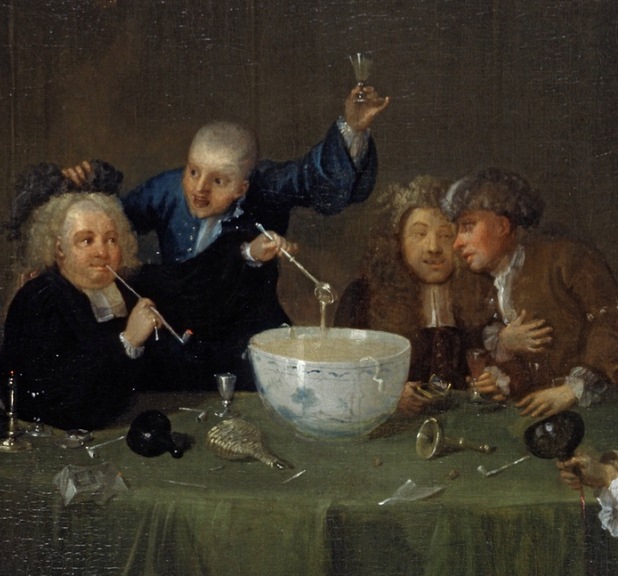
A midnight modern conversation (detail), William Hogarth, c1732. Yale Center for British Art, Paul Mellon Collection
Drink deeper:
Some recent articles on punchbowls are well worth reading. All can be found at the HHTs Caroline Simpson Library & Research Collection, easily accessed at the HHT’s head office on Macquarie Street:
- Elizabeth Ellis, ‘Chinese puzzles, the Sydney punchbowls’, Australiana, May 2012, vol 34, no 2, pp18–30.
- William R Sargent, ‘Hong bowls’ in Treasures of Chinese export ceramics from the Peabody Essex Museum, Yale University Press, New Haven and London, 2012
